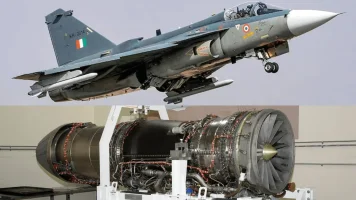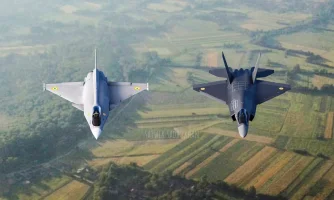- Views: 2K
- Replies: 12
India's pursuit of self-reliance in critical defence technology is set to take another major step forward, as the Defence Research and Development Organisation (DRDO) is exploring the development of a more powerful jet engine for its next generation of unmanned aircraft.
The Gas Turbine Research Establishment (GTRE), a premier DRDO laboratory based in Bengaluru, has proposed creating a new 10-kilonewton (10kN) class turbofan engine to power advanced military drones.
This proposed engine is planned as a scaled-up version of the existing Small Turbo Fan Engine (STFE), also known as the Manik. The current Manik engine produces 4.5kN of thrust (approximately 450 kgf) and has already proven its capabilities.
In a landmark test in October 2022, the STFE successfully powered the Indigenous Technology Cruise Missile (ITCM), demonstrating its reliability for long-duration subsonic flight. This existing engine is designed for platforms like the Nirbhay class of cruise missiles and various unmanned aerial vehicles (UAVs).
The push for a new engine with more than double the thrust addresses the evolving needs of the Indian Armed Forces. A 10kN engine would enable the development of larger and more capable unmanned systems.
Such an engine could support drones that can carry heavier payloads of weapons and sensors, fly for longer periods, and operate at higher altitudes, significantly enhancing India's surveillance and strike capabilities.
Sources indicate this powerful new engine is likely intended for one of two key futuristic programmes.
The first is a jet-powered Medium Altitude Long Endurance (MALE) UAV, designed for strategic reconnaissance over vast areas. The second, and perhaps more prominent candidate, is the CATS Warrior, an autonomous "loyal wingman" drone.
The CATS (Combat Air Teaming System) Warrior is being developed to fly alongside manned fighter jets like the HAL Tejas and the upcoming Advanced Medium Combat Aircraft (AMCA), acting as a force multiplier in combat.
The CATS Warrior is envisioned to perform a range of critical missions, including intelligence gathering, surveillance, reconnaissance (ISR), and launching strikes on enemy targets, all while protecting the more valuable manned aircraft.
A 10kN engine would provide the necessary power for the Warrior to keep pace with fighter jets, operate effectively at altitudes between 30,000 and 40,000 feet, and carry a meaningful weapons load.
The development of the 10kN engine will be built upon the solid foundation of the existing Manik engine's technology. The STFE features a modern, modular design that includes a multi-stage compressor and turbine, which provides a reliable blueprint for scaling up.
Furthermore, the project will benefit from parallel advancements within the DRDO, such as the creation of single-crystal turbine blades by the Defence Metallurgical Research Laboratory (DMRL). These advanced materials are essential for withstanding the extreme temperatures and stresses inside a high-performance jet engine.
This proposal is part of India's wider national effort to master aero-engine technology. It complements other major projects, such as the ongoing flight tests of the larger Kaveri Derivative Engine. This 48.5kN thrust Kaveri engine is slated to power the Ghatak, India's first stealth Unmanned Combat Aerial Vehicle (UCAV).
By developing engines across different thrust classes, India aims to create a comprehensive domestic ecosystem for military propulsion systems.
However, the project is not without challenges. Scaling an engine to double its thrust requires significant engineering work to maintain fuel efficiency and reliability while keeping the weight low.
Furthermore, past experiences with engine development programmes have shown that consistent funding and a clear commitment from the end-users, such as the Indian Air Force or Navy, are crucial to prevent delays and ensure the project's success.


